Amid rising tensions between Russia and NATO over Ukraine, and repeated claims by Western sources that a Russian invasion of its neighbour could be imminent, the British Armed Forces have begun a major airlift to supply Kiev’s forces with light anti armour weapons. This comes as the U.S. is also considering major sales of air defence equipment to the country, which primarily relies on increasingly obsolete 1980s equipment inherited from the Soviet Union for its defence. British Defence Secretary Ben Wallace stated on January 17th when addressing the House of Commons regarding support for Ukraine:
“As of today, tens of thousands of Russian troops are positioned close to the Ukrainian border. Their deployment is not routine, and they are equipped with tanks, armoured fighting vehicles, rocket artillery, and short-range ballistic missiles. I can today confirm to the House that, in light of the increasingly threatening behaviour from Russia, and in addition to our current support, the UK is providing a new security assistance package to increase Ukraine’s defensive capabilities. We have taken the decision to supply Ukraine with light, anti-armour, defensive weapon systems. A small number of UK personnel will also provide early-stage training for a short period of time, within the framework of Operation ORBITAL, before then returning to the United Kingdom. This security assistance package complements the training and capabilities that Ukraine already has, and those that are also being provided by the UK and other Allies in Europe and the United States. Ukraine has every right to defend its borders, and this new package of aid further enhances its ability to do so. Let me be clear: this support is for short-range, and clearly defensive weapons capabilities; they are not strategic weapons and pose no threat to Russia. They are to use in self-defence and the UK personnel providing the early-stage training will return to the United Kingdom after completing it.”

U.S.-supplied C-17 transport aircraft flying from the Royal Air Force base at Brize Norton have been used to transport arms to Ukraine. They notably gave German airspace a wide berth when flying over Europe to avoid the need to request Berlin’s permission, as the country has taken a softer position towards Moscow than London or Washington have. British surveillance aircraft have also been deployed against Russian forces in the region, and shortly before the arms shipments began a Royal Air Force RC-135 surveillance plane carried out a reconnaissance mission against Russian assets in Crimea. Britain has also been training Ukrainian forces since 2015 under Operation ORBITAL, and pursued joint defence projects with Ukraine including supporting the construction of new naval bases and warships in the country and arming its existing naval assts with new missiles.
Ukraine was formerly a part of the Soviet Union, and following Western support for the overthrow of its government in 2014 a new more overtly pro-Western administration has sought to gain admission into the NATO alliance. This has been seen as an unacceptable red line in Russia, which Moscow perceives as a threat to its security as it would lead to significant increases in Western forces deployed to the territory and potentially the deployment of NATO nuclear weapons very close to sensitive Russian targets. Beyond denying Ukraine to NATO, however, the benefits Russia could gain from an invasion remain limited with the country’s economy and major industries having been in steep decline for over three decades and much of its population particularly, in the western regions, having strong pro-Western and anti-Russian sentiments.
